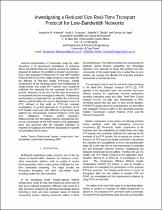 ResearchSpace
ResearchSpace
Investigating a reduced size real-time transport protocol for low-bandwidth networks
JavaScript is disabled for your browser. Some features of this site may not work without it.
- ResearchSpace
- →
- Research Publications/Outputs
- →
- Conference Publications
- →
- View Item
| dc.contributor.author |
Kakande, JN

|
|
| dc.contributor.author |
Ferguson, KL

|
|
| dc.contributor.author |
Dlodlo, ME

|
|
| dc.contributor.author |
De Jager, G

|
|
| dc.date.accessioned | 2012-04-17T10:18:31Z | |
| dc.date.available | 2012-04-17T10:18:31Z | |
| dc.date.issued | 2011-09 | |
| dc.identifier.citation | Kakande, JN, Ferguson, KL, Dlodlo, ME and De Jager, G. Investigating a reduced size real-time transport protocol for low-bandwidth networks. Southern Africa Telecommunication Networks and Applications Conference (SATNAC 2011), East London, South Africa, 4-7 September 2011 | en_US |
| dc.identifier.uri | http://www.satnac.org.za/proceedings/2011/papers.htm | |
| dc.identifier.uri | http://hdl.handle.net/10204/5776 | |
| dc.description | Southern Africa Telecommunication Networks and Applications Conference (SATNAC 2011), East London, South Africa, 4-7 September 2011 | en_US |
| dc.description.abstract | Optimization of bandwidth usage for video streaming is of paramount importance in networks where low bitrate links are typical. Among the solutions proposed to address this problem is header compression. Real-Time Transport Protocol (RTP) and RTP Control Protocol (RTCP) are the major protocols responsible for the delivery of real-time media. Previously, header compression at the hardware layer and multiplexing of media frames into single RTP packets was considered sufficient for reducing the bit overhead of the RTP packets. However, at the very low bit rates encountered in congested and low throughput networks, multiplexing and hardware compression do not suffice for end-to-end delivery and therefore the use of a lightweight version of RTP, defined in this work as RTP-Lite, requires investigation. A cyclical approach to compression of the RTP headers was used with different compression cycle patterns for Transmission Control Protocol (TCP) and User Datagram Protocol (UDP) transport. Measurements over the public Internet showed that end-to-end compression of the RTP header at the application layer was achieved with the expected reduction in required throughput and minimal degradation of packet loss and jitter performance. | en_US |
| dc.language.iso | en | en_US |
| dc.publisher | SATNAC | en_US |
| dc.relation.ispartofseries | Workflow;8052 | |
| dc.subject | End-to-end | en_US |
| dc.subject | Header compression | en_US |
| dc.subject | Low bandwidth | en_US |
| dc.subject | Multimedia streaming | en_US |
| dc.subject | Real-Time Transport Protocol (RTP) | en_US |
| dc.title | Investigating a reduced size real-time transport protocol for low-bandwidth networks | en_US |
| dc.type | Conference Presentation | en_US |
| dc.identifier.apacitation | Kakande, J., Ferguson, K., Dlodlo, M., & De Jager, G. (2011). Investigating a reduced size real-time transport protocol for low-bandwidth networks. SATNAC. http://hdl.handle.net/10204/5776 | en_ZA |
| dc.identifier.chicagocitation | Kakande, JN, KL Ferguson, ME Dlodlo, and G De Jager. "Investigating a reduced size real-time transport protocol for low-bandwidth networks." (2011): http://hdl.handle.net/10204/5776 | en_ZA |
| dc.identifier.vancouvercitation | Kakande J, Ferguson K, Dlodlo M, De Jager G, Investigating a reduced size real-time transport protocol for low-bandwidth networks; SATNAC; 2011. http://hdl.handle.net/10204/5776 . | en_ZA |
| dc.identifier.ris | TY - Conference Presentation AU - Kakande, JN AU - Ferguson, KL AU - Dlodlo, ME AU - De Jager, G AB - Optimization of bandwidth usage for video streaming is of paramount importance in networks where low bitrate links are typical. Among the solutions proposed to address this problem is header compression. Real-Time Transport Protocol (RTP) and RTP Control Protocol (RTCP) are the major protocols responsible for the delivery of real-time media. Previously, header compression at the hardware layer and multiplexing of media frames into single RTP packets was considered sufficient for reducing the bit overhead of the RTP packets. However, at the very low bit rates encountered in congested and low throughput networks, multiplexing and hardware compression do not suffice for end-to-end delivery and therefore the use of a lightweight version of RTP, defined in this work as RTP-Lite, requires investigation. A cyclical approach to compression of the RTP headers was used with different compression cycle patterns for Transmission Control Protocol (TCP) and User Datagram Protocol (UDP) transport. Measurements over the public Internet showed that end-to-end compression of the RTP header at the application layer was achieved with the expected reduction in required throughput and minimal degradation of packet loss and jitter performance. DA - 2011-09 DB - ResearchSpace DP - CSIR KW - End-to-end KW - Header compression KW - Low bandwidth KW - Multimedia streaming KW - Real-Time Transport Protocol (RTP) LK - https://researchspace.csir.co.za PY - 2011 T1 - Investigating a reduced size real-time transport protocol for low-bandwidth networks TI - Investigating a reduced size real-time transport protocol for low-bandwidth networks UR - http://hdl.handle.net/10204/5776 ER - | en_ZA |





